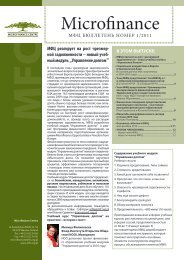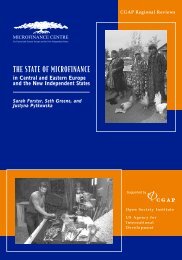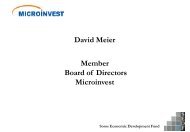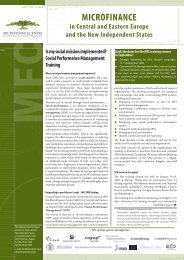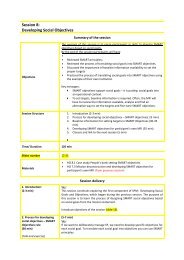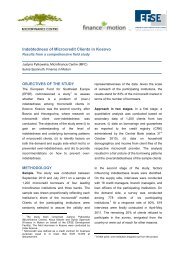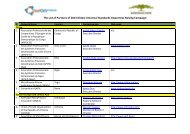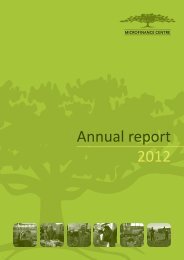Value Chains research report Tajikistan final - Microfinance Centre
Value Chains research report Tajikistan final - Microfinance Centre
Value Chains research report Tajikistan final - Microfinance Centre
You also want an ePaper? Increase the reach of your titles
YUMPU automatically turns print PDFs into web optimized ePapers that Google loves.
• Attacks by common bee eater (bird eating bees and causing great damage to<br />
beekeeping sector).<br />
Usually honey collecting season begins in the second half of March; in the<br />
South of <strong>Tajikistan</strong> the season starts in early spring (see seasonality data in Table 52).<br />
Mass harvest starts in April-May (fruit trees, etc.). Caligonum, wild alfalfa, poppies and<br />
bean caperbush start blooming in arid and semi-arid areas; tulips, almonds, hawthorn<br />
and cherry plum in the mountains. False acacia and fruit trees – in oasis areas. Also,<br />
in April beekeepers must look for new place to collect honey, as the yield in oasis<br />
areas is dropping rapidly. As days get warmer and amounts of nectar and pollen<br />
increase, bee families grow quickly. At this time, additional comb foundation needs to<br />
be prepared – six frames per bee family. Honey yield ends in late August –<br />
September. In the first or second ten days of August beekeepers conduct <strong>final</strong> honey<br />
loosening and take measures to grow strength of bee families for the winter.<br />
Beekeeper must monitor nectar weight increases in the control family on a daily<br />
basis, discard old frames and melt them into wax. Father families are marked for<br />
growing drones and inseminating young autumn-born females.<br />
In September, bee houses are taken to wintering grounds or to residual nectarbearing<br />
plants – these may be melons or yulgun bush. These can have enough nectar<br />
to support the bees during winter. During this time, the beekeepers seal all cracks and<br />
slots in the bee houses. The bee houses are thoroughly insulated against cold (using<br />
canvas, pillows), entrances are reduced. If food is not sufficient for the winter, some of<br />
the honey, candy (mixture of honey and sugar powder) or sugar syrup is left for winter;<br />
however, this feeding is a forced measure.<br />
In the subsequent months, until a new season begins, bees are monitored<br />
every two weeks using a rubber hose inserted into bee-house entrance, spare empty<br />
combs are sorted. Backup bee-houses and accessories are repaired, wax is replaced<br />
with comb foundations. Next, beekeepers make up a plan of activities for the next year<br />
and analyze the yield from the past season.<br />
Starting end of February – beginning of March, beekeepers’ work intensifies.<br />
They have to review the bee yard and prepare for the new honey collection season.<br />
The season starts in March in Sughd Region and a little later in other areas. The yield<br />
depends on the bee yard, the strength of bee families, location and weather, and<br />
usually lasts till the end of October. Honey is pumped using centrifuge – this is called<br />
centrifugal method.<br />
Table 52 shows the calendar of beekeepers’ seasonal activities. Analysis shows<br />
that feeding is performed mostly until May-June. Breeding begins at various times in<br />
various districts. This allows preparing bee packs in one district before starting the<br />
same activity in another one; this can be done until June.<br />
When analyzing the production of honey and the data presented in below table,<br />
we can make important conclusions for the purpose of marketing honey and<br />
secondary products. Honey is sold throughout the year, bee families and bee packs –<br />
107




